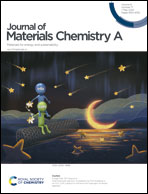Achieving a 2.7 V aqueous hybrid supercapacitor by the pH-regulation of electrolyte†
Abstract
The output voltage directly determines the energy density of supercapacitors (SCs), and it is closely associated with the type of electrolyte. Here we demonstrate the great feasibility of using a pH-regulation strategy in neutral sodium sulfate electrolyte to widen the voltage window (0–1.3 V) and to achieve an additional redox capacity (234% increase) for sodium-embedded manganese oxide/nitrogen-doped graphene (denoted NMO–NDs@NG) electrode at the same time. The mechanism of the strategy was systematically explored by various in situ and ex situ characterizations, as well as density functional theory calculations. The NMO–NDs@NG showed a surface-controlled pseudocapacitive behavior in the neutral electrolyte, but mainly displayed a battery-like behavior in the alkaline electrolyte. Upon increasing the pH value of the initial neutral electrolyte, the emerging reversible redox reaction effectively inhibited water decomposition occurring on the electrode surface, thereby expanding the voltage window as well as increasing the capacity. Based on this, an aqueous hybrid SC was assembled, which was able to work at 2.7 V and presented a maximum energy density of 68 W h kg−1 and a maximum power density of 27 kW kg−1. The results presented here provide a useful strategy for achieving high-voltage and high-capacity aqueous SCs.



 Please wait while we load your content...
Please wait while we load your content...